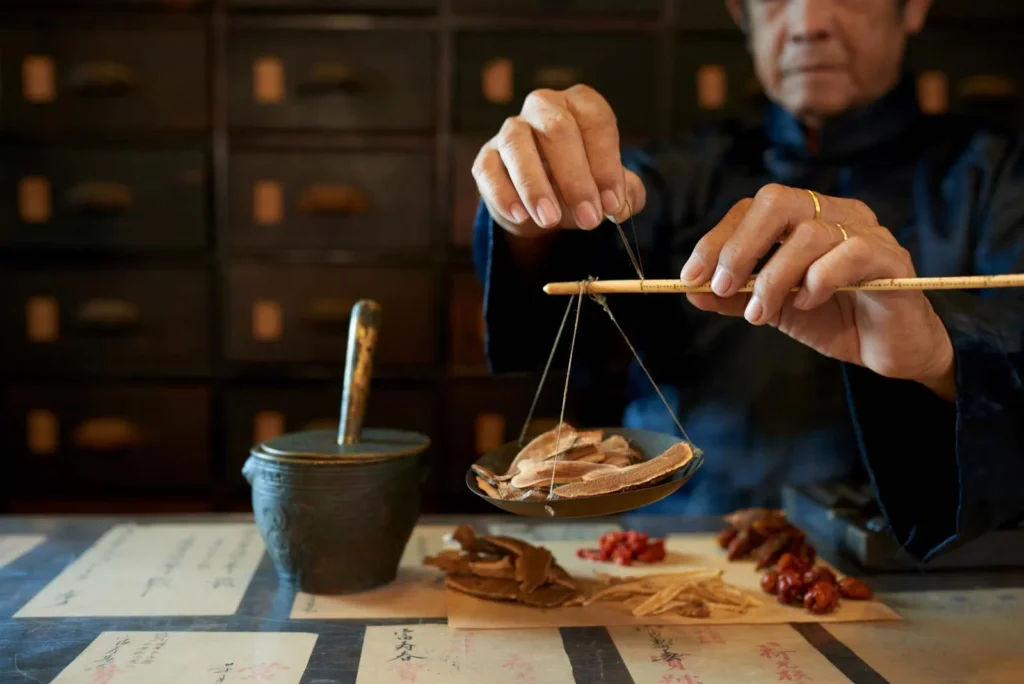Traditional Chinese Medicine (TCM) is a comprehensive system of healing that encompasses various ancient practices aimed at promoting health and well-being. It is rooted in a holistic understanding of the human body and its connection to nature. In this article, we delve into the power of Traditional Chinese Medicine, exploring its ancient healing practices that have stood the test of time.

Understanding Acupuncture: A Timeless Approach to Health and Wellness
Acupuncture is a cornerstone of Traditional Chinese Medicine and has been practiced for thousands of years. This ancient technique involves the insertion of thin needles into specific points on the body to stimulate energy flow and restore balance. By targeting these points, acupuncture aims to alleviate pain, promote healing, and enhance overall well-being.
Herbal Medicine: Unveiling the Secrets of Nature’s Remedies in Traditional Chinese Medicine
Herbal medicine is another integral aspect of Traditional Chinese Medicine, relying on the use of natural substances derived from plants, minerals, and animal products. These herbs are carefully selected and combined to create powerful formulas that address specific health conditions. With a history dating back thousands of years, herbal medicine in TCM offers a treasure trove of remedies for various ailments.
Qi Gong: Harnessing Life Energy for Balance and Vitality
Qi Gong is a practice that combines movement, breathing techniques, and meditation to cultivate and balance the body’s vital energy, known as Qi. It aims to promote physical health, mental clarity, and emotional well-being. With its gentle exercises and focus on deep breathing, Qi Gong is a powerful tool for maintaining balance and vitality.
Cupping Therapy: Ancient Chinese Technique for Pain Relief and Detoxification
Cupping therapy involves placing special cups on the skin to create a vacuum, drawing the skin and underlying tissues upward. This technique promotes blood circulation, relieves muscle tension, and facilitates detoxification. Dating back to ancient times, cupping therapy remains a popular and effective treatment in Traditional Chinese Medicine.
Chinese Herbal Formulas: Unlocking the Healing Potentials of Nature’s Pharmacy
Chinese herbal formulas are carefully crafted combinations of herbs designed to address specific health imbalances. These formulas have been developed and refined over centuries, with each herb chosen for its unique properties and interactions. Chinese herbal formulas offer a holistic approach to healing, treating not only the symptoms but also the underlying causes of illness.
The Five Elements Theory in Traditional Chinese Medicine: Balancing Body and Mind
The Five Elements Theory is a fundamental concept in TCM that categorizes the world and the human body into five elements: Wood, Fire, Earth, Metal, and Water. Each element is associated with specific organs, emotions, and characteristics. By understanding the interactions and imbalances of these elements, TCM practitioners can diagnose and treat various health conditions.
Meridian Therapy: Restoring Energy Flow for Optimal Health
Meridian therapy focuses on the body’s energy pathways, known as meridians, through which Qi flows. By stimulating specific points along these meridians, practitioners aim to restore the smooth flow of energy, balance Yin and Yang, and promote overall health. Meridian therapy includes practices such as acupuncture, acupressure, and moxibustion.
Tai Chi: The Ancient Art of Moving Meditation for Health and Harmony
Tai Chi is a graceful form of exercise that combines flowing movements, deep breathing, and mental focus. Rooted in martial arts, it is now widely practiced for its numerous health benefits, including improved balance, flexibility, and stress reduction. Tai Chi cultivates harmony between body, mind, and spirit, promoting overall well-being.
Tui Na Massage: Traditional Chinese Bodywork for Relaxation and Healing
Tui Na massage is a therapeutic bodywork technique that utilizes various hand techniques and manipulations to stimulate acupressure points, meridians, and muscles. It aims to balance the body’s energy, relieve pain, and promote healing. Tui Na massage is often used in conjunction with other TCM therapies for enhanced therapeutic effects.
Traditional Chinese Medicine Diagnosis: Unlocking Clues to Health and Wellbeing
Traditional Chinese Medicine diagnosis is a comprehensive system of assessment that takes into account various factors, including observing the tongue, palpating the pulse, and analyzing symptoms and medical history. By considering the individual’s unique constitution and patterns of disharmony, TCM diagnosis provides valuable insights into health imbalances and guides personalized treatment approaches.
The Yin and Yang Philosophy in Chinese Medicine: Achieving Balance for Wellness
Yin and Yang are opposing yet interconnected forces in TCM philosophy. Yin represents the cool, passive, and nourishing aspects, while Yang symbolizes the warm, active, and transformative qualities. Achieving balance between Yin and Yang is essential for overall well-being. TCM treatments aim to restore and maintain this delicate equilibrium within the body.
Incorporating these ancient healing practices into our lives can help us tap into the power of Traditional Chinese Medicine, promoting health, balance, and well-being. By embracing these time-tested practices, we can unlock the secrets of ancient wisdom and enhance our overall quality of life.









